Business Models & Mental Models
I’m just back from Amsterdam doing some workshops with our Grove partners, Business Models, Inc. Gisela Wendling, The Grove’s Director of Global Learning, and I conducted a public workshop on Visualizing Change for 25 consultants and an internal workshop on Mental Models & Mindsets for BMI as the kickoff to their International Week. I want to share this experience of teaching systems thinking through drawing practice, which echoed my first meeting with Patrick Van Der Pijl, BMI’s founder, at a VizThink conference in Berlin 3-4 years ago.
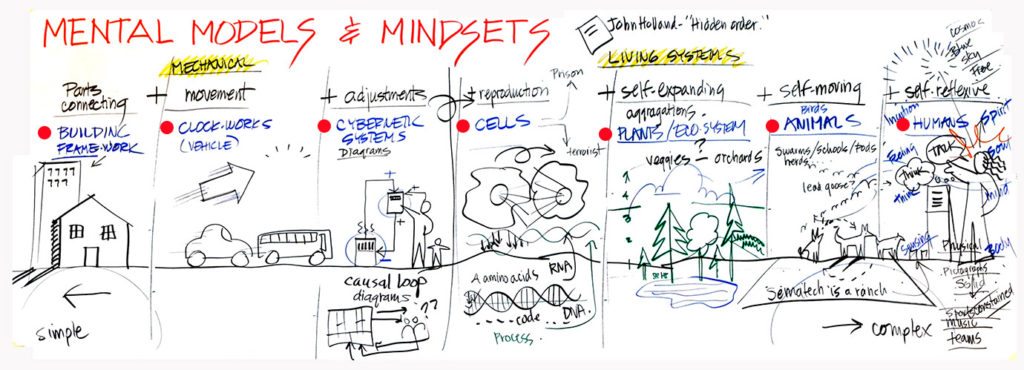
Some Background
Patrick was the producer partner on the five-person team that created the breakout business book Business Model Generation, originally self published and then picked up by Wiley & Sons. It’s over 500,000 copies worldwide in 25 languages. The book is built around the now well-known Business Model Canvas, developed by Alex Osterwalder in his Ph.D. work. But pre-publication Patrick bumped into me in Berlin and attended a workshop I gave on mental models and graphics. Lights went off. He saw that if he combined the Business Model Canvas with our strategic visioning Graphic Guide templates, he could have a complete consulting offering. He did that, licensed our templates for use with clients, and has watched his business explode. In three years they are now at eight offices in almost as many countries.

Because this was the kickoff for BMI’s International Week, and rapid growth has resulted in some seven of the 25 who would be attending new to the group as a whole, Gisela and I wanted to create an experience that would really help them get to know each other, AND bump up their drawing and thinking skills. Maaike Doyer, one of their top strategy designers who is going to help open an office in the SF Bay Area for BMI, came over to San Francisco and worked out the agenda. We had people do introductory interview portraits of each other to start, then I presented the mental models shown earlier.
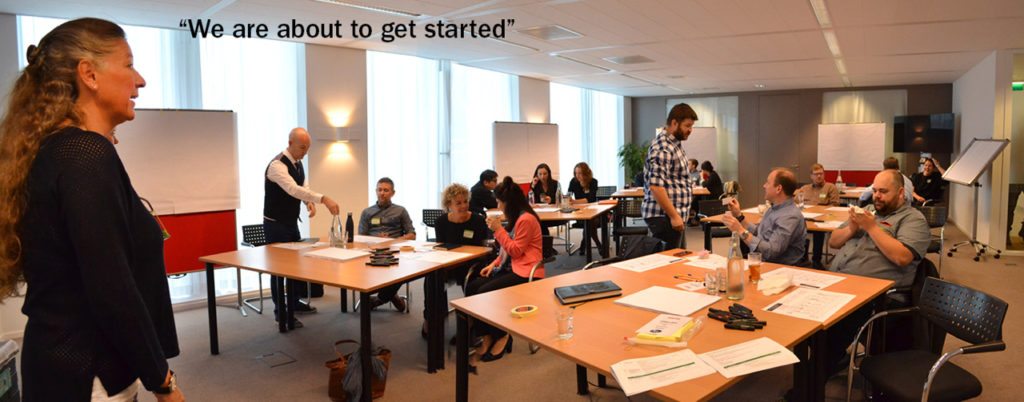
This was to both teach some drawing and thinking, and set up an exercise where teams would pick one of the models (think metaphors) and answer the questions “BMI is like a…). The way I approached the challenge of explaining this framework was a breakthrough for me.
Seven Frameworks for Thinking
Why was this a challenge? Mostly because I love complex, comprehensive models and can get carried away with language and connection. I got this one from Kenneth Boulding, who wrote a seminal book called The Image: Knowledge in Life and Society in the late 1950s. He was working to understand the impact of images on behavior and suggests there are seven basic frameworks for thinking that progress from simple to complex. I found Boulding’s work while studying with Arthur M. Young’s Theory of Process in the 1970s and the seven stages in this model of evolutionary process were so similar I took it as an affirmation of the insights of the theory. (You see why it’s a challenge to be simple). I included the framework in my book for managers about visualization called Visual Leaders: New Tools for Visioning, Management & Organizational Change (page 58).
With BMI I decided to introduce this by showing everyone how to draw the different iconic graphics that illustrate each type of thinking, and generalize about how this graphic vocabulary can help facilitate clients becoming aware of their own mental models and mindsets. These ways of thinking often become habitual “lens” or “filters” that individuals and management teams use to understand the complexity of their organizations and environments.
 FRAMEWORKS are structures that have parts that connect, like picture frames, buildings, and banks. Have you seen organizational visions illustrated as having roof missions, pillars, and steps? These are simple, effective holders that show relationships between parts. You draw “drop lines” and “horizon lines” to get these pictures.
FRAMEWORKS are structures that have parts that connect, like picture frames, buildings, and banks. Have you seen organizational visions illustrated as having roof missions, pillars, and steps? These are simple, effective holders that show relationships between parts. You draw “drop lines” and “horizon lines” to get these pictures.
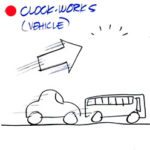 CLOCKWORKS are models that have parts that connect AND move. These are the cars and buses, other vehicles and machines we all know well. Moving adds complexity. Cartoonists do it with “movement lines” that come along after the object. Turn your chisel tip pen over and make smaller, parallel lines following the base line of the drawing.
CLOCKWORKS are models that have parts that connect AND move. These are the cars and buses, other vehicles and machines we all know well. Moving adds complexity. Cartoonists do it with “movement lines” that come along after the object. Turn your chisel tip pen over and make smaller, parallel lines following the base line of the drawing.
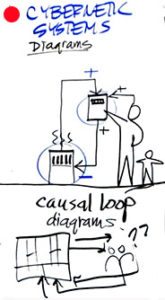 CYBERNETIC SYSTEMS are parts that connect, move, AND adjust to feedback. Think thermostat. Of course part of the system is the human who sets the temperature. Graphic facilitators use connection arrows to diagram feedback loops. For BMI I sketched out a small version of the canvass (two “Hs” on a based line) and suggested there is a cybernetic relationships between the image and the group thinking process. Anyone who teaches systems thinking, which is rooted in cybernetic thinking, used causal loop diagrams to illustrate the different concepts and do the analysis. Being able to have little illustrations rather than just circles and boxes can liven up one of these kinds of drawings.
CYBERNETIC SYSTEMS are parts that connect, move, AND adjust to feedback. Think thermostat. Of course part of the system is the human who sets the temperature. Graphic facilitators use connection arrows to diagram feedback loops. For BMI I sketched out a small version of the canvass (two “Hs” on a based line) and suggested there is a cybernetic relationships between the image and the group thinking process. Anyone who teaches systems thinking, which is rooted in cybernetic thinking, used causal loop diagrams to illustrate the different concepts and do the analysis. Being able to have little illustrations rather than just circles and boxes can liven up one of these kinds of drawings.
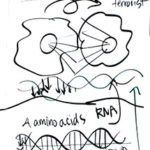 CELLS are things whose parts connect, move, adapt AND reproduce. This brings a whole new level of complexity when we use living systems metaphors to think with. With graphics, reproduction is illustrated creating a second drawing that mirrors the first, and connecting it with arrows. I inquired how many knew how cells really worked. A few did. I explained how DNA breaks into two stands and replicates itself with its amino acid code along the strands. This kind of mindset is used to think about rapidly replicating organizations, like terror cells.
CELLS are things whose parts connect, move, adapt AND reproduce. This brings a whole new level of complexity when we use living systems metaphors to think with. With graphics, reproduction is illustrated creating a second drawing that mirrors the first, and connecting it with arrows. I inquired how many knew how cells really worked. A few did. I explained how DNA breaks into two stands and replicates itself with its amino acid code along the strands. This kind of mindset is used to think about rapidly replicating organizations, like terror cells.
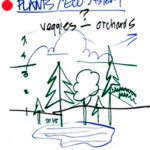 PLANTS provide a way of thinking about things that have parts that connect, move, adapt, reproduce and do this as aggregations or ecosystems of livings cells. I showed everyone how to draw different kinds of trees, water, clouds and create little environments on their charts. Farmers and gardeners understand this way of thinking, where observation, maintenance, nurturance, and reseeding are all parts of the model. It’s a more comprehensive way to think but also more complex—like nature.
PLANTS provide a way of thinking about things that have parts that connect, move, adapt, reproduce and do this as aggregations or ecosystems of livings cells. I showed everyone how to draw different kinds of trees, water, clouds and create little environments on their charts. Farmers and gardeners understand this way of thinking, where observation, maintenance, nurturance, and reseeding are all parts of the model. It’s a more comprehensive way to think but also more complex—like nature.
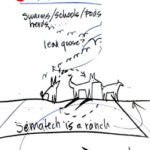 ANIMALS provide a way of thinking about things that have parts that connect, move, adapt, reproduce, aggregate, and self-move in groups. I showed everyone how to draw a “star dog” and “star coyote,” drawing from the way The Grove teaches people to create “star persons.” I also shared a story of using this way of thinking at Sematech, when we compared that semiconductor collaborative to a ranch. Intel projects were predators. Consultants were the rodents! For those who actually ranched, this was a rich framework.
ANIMALS provide a way of thinking about things that have parts that connect, move, adapt, reproduce, aggregate, and self-move in groups. I showed everyone how to draw a “star dog” and “star coyote,” drawing from the way The Grove teaches people to create “star persons.” I also shared a story of using this way of thinking at Sematech, when we compared that semiconductor collaborative to a ranch. Intel projects were predators. Consultants were the rodents! For those who actually ranched, this was a rich framework.
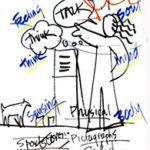 HUMANS themselves provide one of our most common frameworks for thinking, by analogizing with other forms of organization or other people. Humans have all of the features of the other models AND self reflection. I showed how cartoonists have come to draw humans in a holistic way, by drawing little pictographs of the physical part, the body, using text balloons and thought balloons for the thinking aspect; using color and line quality for the feeling level; and using auras and light burst drawings to show consciousness. Using graphics systematically to reflect the levels of thinking and awareness in a group helps bring everyone to a new level of consciousness.
HUMANS themselves provide one of our most common frameworks for thinking, by analogizing with other forms of organization or other people. Humans have all of the features of the other models AND self reflection. I showed how cartoonists have come to draw humans in a holistic way, by drawing little pictographs of the physical part, the body, using text balloons and thought balloons for the thinking aspect; using color and line quality for the feeling level; and using auras and light burst drawings to show consciousness. Using graphics systematically to reflect the levels of thinking and awareness in a group helps bring everyone to a new level of consciousness.
I was really struck by how wonderful it was to teach drawing and now try and get at these ideas with big conceptual words. Everyone loved the exercise. And the following one of using these frameworks to think about their own organizations cracked open the energy.
I’ve come to believe that active drawing is the way our brains install new systems-level understanding of things. It is one of the most direct and widespread ways of making sense out of complexity. It’s no wonder that not only visual practice, but consulting approaches like BMI that are built on clear, graphic frameworks are so well received.
Upcoming Workshops
Gisela and I are leading a Designing and Leading Change workshop this August and September in San Francisco if you want to partake in this kind of thinking and exploration first-hand.


Sibrenne Wagenaar
July 8, 2015Hello Mike, thank you for sharing these seven types of thinking. Unfortunately, I missed your workshop here in The Netherlands 🙂
I can imagine the difference in effect between these types. And I liked the way you used it in this workshop. Were people able to choose between them? And how did that go? Do you think you have a preferred type of thinking? Or you choose one that feels right according to the subject, to see what the dialogue and process will bring you?
Tarek Fahmy
June 16, 2015Where can I get more details on this tool? which one of your books?